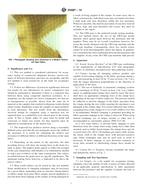Potrebujeme váš súhlas na využitie jednotlivých dát, aby sa vám okrem iného mohli ukazovať informácie týkajúce sa vašich záujmov. Súhlas udelíte kliknutím na tlačidlo „OK“.
ASTM D5587-14
Standard Test Method for Tearing Strength of Fabrics by Trapezoid Procedure
Automaticky preložený názov:
Štandardná skúšobná metóda pre Trhanie Pevnosť tkaniny by lichobežníka poriadku
NORMA vydaná dňa 15.2.2014
Informácie o norme:
Označenie normy: ASTM D5587-14
Poznámka: NEPLATNÁ
Dátum vydania normy: 15.2.2014
Kód tovaru: NS-31781
Počet strán: 7
Približná hmotnosť: 21 g (0.05 libier)
Krajina: Americká technická norma
Kategória: Technické normy ASTM
Anotácia textu normy ASTM D5587-14 :
Keywords:
fabric, tearing strength, trapezoid, ICS Number Code 59.080.30 (Textile fabrics)
Doplňujúce informácie
| Significance and Use | ||||||||||||||
|
5.1 This test method is considered satisfactory for acceptance testing of commercial shipments because current estimates of between-laboratory precision are acceptable, and this test method is used extensively in the trade for acceptance testing. 5.2 If there are differences of practical significance between test results for two laboratories (or more), comparative test should be performed to determine if there is a statistical bias between them, using competent statistical assistance. As a minimum, use the samples for such a comparative test that are as homogeneous as possible, drawn from the same lot of material as the samples that resulted in disparate results during initial testing. Randomly assign the samples in equal numbers to each laboratory. The test results from the laboratories involved should be compared using a statistical test for unpaired data, at a probability level chosen prior to the testing series. If bias is found, either its cause must be found and corrected, or future test results for that material must be adjusted in consideration of the known bias. 5.3 The trapezoid tear produces tension along a reasonably defined course such that the tear propagates across the width of the specimen. It is useful for estimating the relative tear resistance of different fabrics or different directions in the same fabric. 5.4 Depending on the nature of the specimen, the data recording devices will show the tearing force in the form of a peak or peaks. The highest peaks appear to reflect the strength of the yarn components, individually or in combination, needed to stop a tear in fabrics of the same construction. The valleys recorded between the peaks have no specific significance. The minimum tearing force, however, is indicated to be above the lowest valleys. 5.5 Most textile fabrics can be tested by this test method. Some modification of clamping techniques may be necessary for a given fabric, depending upon its structure. Strong fabrics or fabrics made from glass fibers require special adaptation to prevent them from slipping in the clamps or being damaged as a result of being gripped in the clamps. In some cases, due to fabric constructions, individual yarns may not rupture but show a high peak and yarn distortion within the test specimen. Wherever possible, this shall be prevented. If you have tried all of these steps and yarn distortion still occurs, this must be included in the report. 5.6 The CRE-type is the preferred tensile testing machine. This test method allows the use of the CRT-type tensile machine when agreed upon between the purchaser and the supplier. There may be no overall correlation, however, between the results obtained with the CRT-type machine and the CRE-type machine. Consequently, these two tensile testers cannot be used interchangeably unless the degree of quantitative correlation has been established between the purchaser and the supplier. In any event, the CRE-type machine shall prevail. |
||||||||||||||
| 1. Scope | ||||||||||||||
|
1.1 This test method covers the measurement of the tearing strength of textile fabrics by the trapezoid procedure using a recording constant-rate-of-extension-type (CRE) tensile testing machine. 1.1.1 The CRE-type tensile testing machine has become the preferred test apparatus for determining trapezoid tearing strength. It is recognized that some constant-rate-of-traverse-type (CRT) tensile testing machines continue to be used. Consequently, these test instruments may be used when agreed upon between the purchaser and the supplier. The conditions for use of the CRT-type tensile tester are included in 1.2 This test method applies to most fabrics including woven fabrics, air bag fabrics, blankets, napped fabrics, knitted fabrics, layered fabrics, pile, and nonwoven fabrics. The fabrics may be untreated, heavily sized, coated, resin-treated, or otherwise treated. Instructions are provided for testing specimens with or without wetting. 1.3 Tearing strength, as measured in this test method, requires that the tear be initiated before testing. The reported value obtained is not directly related to the force required to initiate or start a tear. 1.4 Two calculations for trapezoid tearing strength are provided: the single-peak force and the average of five highest peak forces. 1.5 The values stated in SI units are to be regarded as the standard. The values stated in inch-pound units may be approximate. 1.6 This standard does not purport to address all of the safety concerns, if any, associated with its use. It is the responsibility of the user of this standard to establish appropriate safety and health practices and determine the applicability of regulatory limitations prior to use. |
||||||||||||||
| 2. Referenced Documents | ||||||||||||||
|
Odporúčame:
Aktualizácia technických noriem
Chcete mať istotu, že používate len platné technické normy?
Ponúkame Vám riešenie, ktoré Vám zaistí mesačný prehľad o aktuálnosti noriem, ktoré používate.
Chcete vedieť viac informácií ? Pozrite sa na túto stránku.




 Cookies
Cookies
